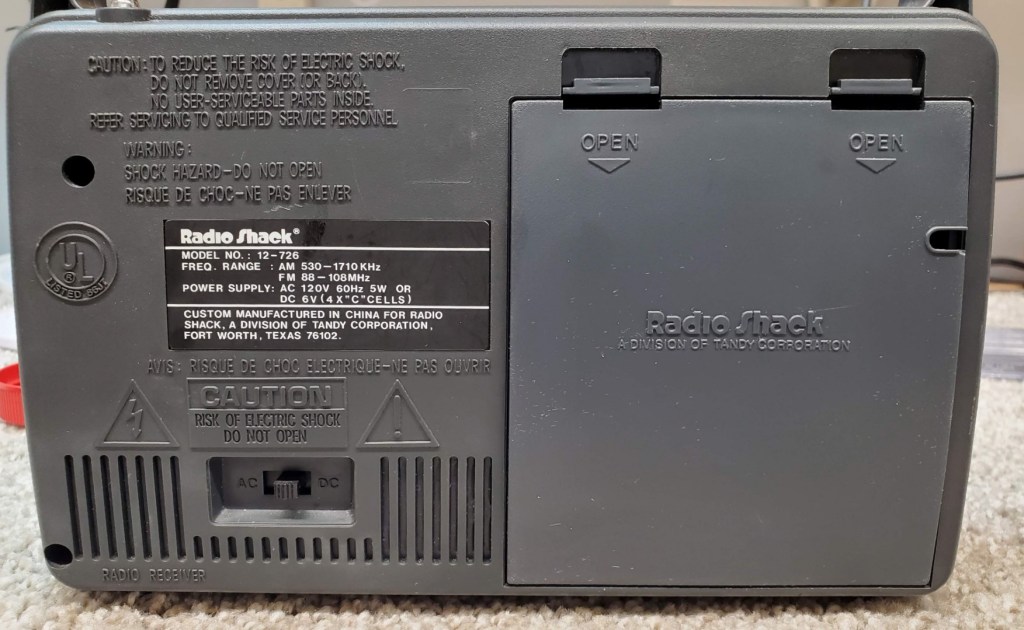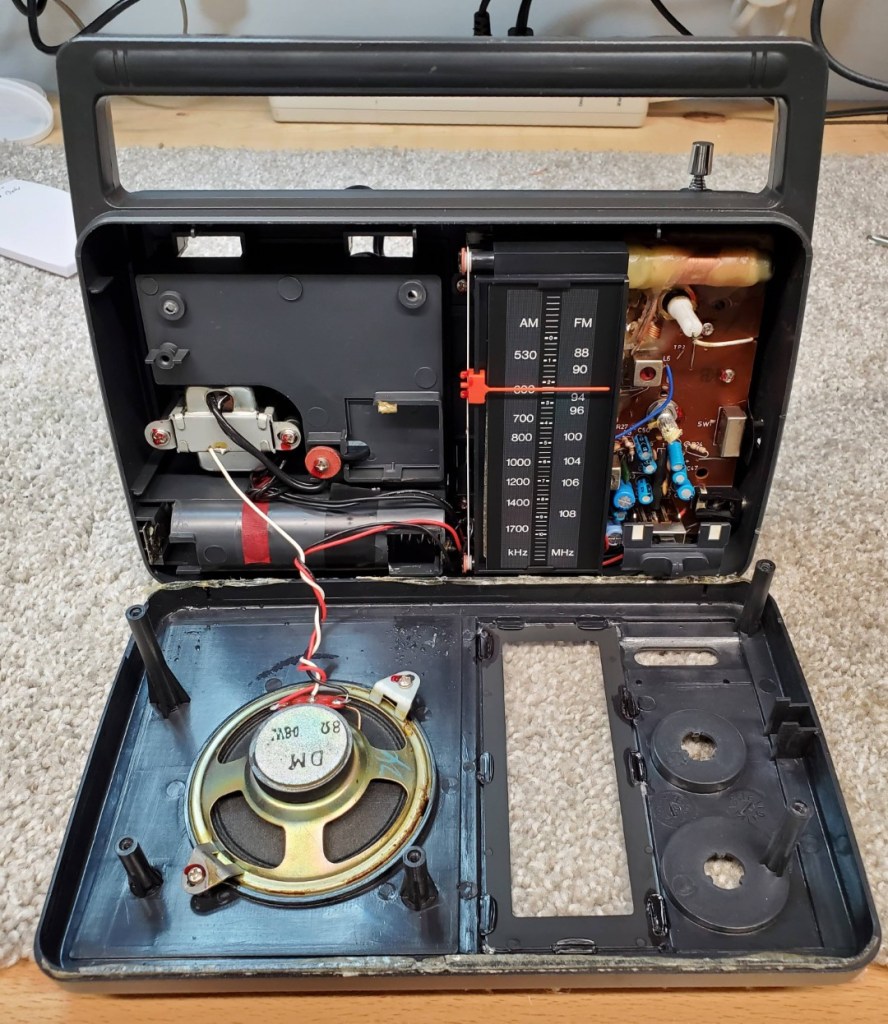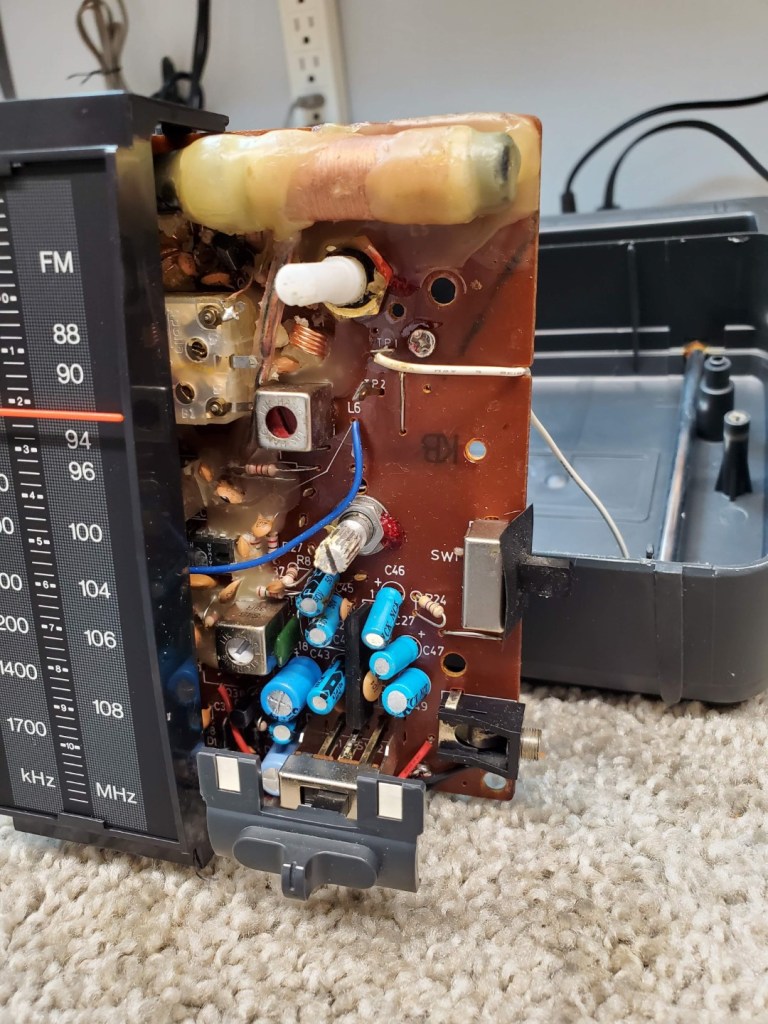Radio Shack/Optimus/Realistic 12-726 AM/FM Portable

The Radio Shack 12-726 is one of many seemingly pedestrian portables Radio Shack offered over the years. At the time these were current I had little interest in them, assuming they were mediocre performers bought by people who were not radio nuts like me and not in the same league as some of the sexier radios then being offered by companies like Sony, Panasonic, Toshiba, Channel Master, Zenith and others. Lately however I’ve become more interested in old-school AM or AM/FM analog radios and curious to see how they perform compared with the best portables of the day as well as some of today’s digital radios. First, a bit of history.

Back in the 1950’s through the 80’s portable radios were enjoying explosive growth and were improving rapidly. The earliest models were novel, exciting and were our constant companions but their actual performance was far below what a truly good radio could do. You could listen comfortably to many weaker stations on a good car radio which were barely audible traces on your portable radio. There were some exceptions of course such as the large, heavy and expensive GE P780 series as well as some higher end models from Panasonic, Sony, Zenith and others, but the more common and affordable portables from that era were much less sensitive. But with evolving technology through the 70’s and 80’s even relatively inexpensive portable radios were becoming much more sensitive on AM. FM was also becoming mainstream with many AM/FM portables available but many – I should say most – had mediocre FM performance by today’s standards.

Today’s good portables (2021) are phenomenal on FM and excellent on SW, but few rate higher than *** on my AM Mega Shootout list. And only a select few of the very best digital portables offer tuning which is fairly seamless with no muting or obvious channel steps which are part of the digital landscape. Extremely sophisticated digital radios can simulate the smooth analog tuning feel but the vast majority do not. I decided to investigate a few vintage analog AM/FM radios to see what I missed back in the day and how they would match up to what you might buy today. I will also be reviewing a few other Radio Shack AM/FM lunchbox-sized portables in the coming weeks. (Note: I am discussing Radio Shack’s own branded and exclusive AM/FM models, not any of the rebranded clones they sold which were made by Grundig, Sangean, Sony and other companies).
The first of these articles looks at the unassuming Radio Shack 12-726, also seen as the Optimus 12-726 or Realistic 12-726, which sold for $24.99 between 1994 – 2000. A simple AM/FM model it did offer two additional features – a Hi/Lo Tone switch and built-in AC power supply, which was very common in those years. I found what looked like a nice one on eBay for a low price and grabbed it.

Initial Observations & Disassembly: The radio arrived and looked pretty good…it just needed some light cosmetic cleaning. But I noticed some wetness in the battery compartment from a recent battery leak, the volume control was staticky and the tuning seemed to slip towards the high end of the band. Clearly this would give me reason enough to open it up and look inside to see how it was made.
Ater removing 5 screws and two knobs the case seemed to still be tightly held together…I could not get it to loosen a bit. I had no choice but to try to pry it at the bottom where any damage would not be obvious and eventually it began to separate but was extremely resistant to this due to some very tenacious sticky adhesive all around all the edges. (I left it intact and when I later reassembled the radio it sealed tightly. I’ve never seen this kind of treatment before but it seems effective.

The slipping dial string was a simple fix. The cord itself looked perfect and had not stretched…the tension spring on the tuning wheel was still fully extended. The pulleys on which the string rides are not really pulleys…they are immovable guides. I cleaned the string, the dial pointer guide and the tuning shaft to no avail so I ended up applying some liquid rosin to the string and that cured it completely. I also found that the volume control was one of those almost completely sealed units which would be difficult to spray with control cleaner but during the time the radio was on the bench the noise cleared itself on its own…it just needed to be used a little and it is still working smoothly with no static whatsoever.

On a general construction note I found this is not a radio that would be easily serviced because most of the circuit board is covered by the tuning dial scale and its string…they would have to be undone to gain access. It could certainly be done if needed but would best be avoided unless really necessary. I also noticed that the ferrite rod is only about 3 ¼ inches long but at least it is of good cross section. While the radio was still on the bench, I was curious to check the dial calibration and found it was much better than I had expected…in fact it was virtually perfect up and down both AM and FM bands – you gotta love that. Due to the poor access I opted to not try to align the radio but with the dial calibration this accurate and overall performance seemingly better than I might have expected I judged that there would be little if any improvement. I think that the technology was sufficiently advanced by this time that the circuits are very stable. It does contain an IC which is may be partly responsible for this but I have no schematic for this radio.

Performance: After buttoning the radio back up I did some casual band scanning and found the radio to be performing very well onAM. I ended up comparing it side by side with several reference radios and was surprised to see it ranked *** on the AM Mega Shootout list (**1/2 on the FM Mega List). I say surprised because this was Radio Shack’s least expensive full-sized (aka lunchbox-sized) AM/FM radio. Three Stars on AM is not too shabby and in fact it is as good as most of today’s multiband portables (radios containing SW as well as AM and FM). To get better AM today you generally have to go to dedicated AM/FM only radios. In the daytime, weak signals were received very well and the radio is sensitive and selective enough to let you hear almost all of the nighttime skip very well. The two-position tone control also strikes a nice balance with good signals sounding clear and natural in the High setting while weak or noisy signals are cleared up nicely in the Low position…it is handy. Overall, I like this radio a lot on AM.
FM was as I had expected less impressive, primarily because today’s radios have improved so markedly, particularly in FM selectivity which is much more of an issue today than in the past. Most typical vintage portables have very poor FM selectivity and that was the case here. Strong signals spread out and covered weaker ones. In a remote area with a less crowded FM band this won’t be as much of a problem but in most locations a modern portable will do much better on FM. FM Sensitivity was adequate for normal reception but this is not a super sensitive set on FM. Also, it is unfortunate that the FM whip antenna has no swivel which precludes precise positioning it when it could have helped.

Conclusion: Clearly, I was more impressed with the 12-726 on AM than I had expected to be and I think it benefitted from improvements in technology which had been made by the mid ‘90’s.. I have been using it for the past several weeks as a daily player and I have been very happy with it – easily earned its *** AM Rating. At a typical eBay price of $20 plus shipping it is a bargain and I would imagine the specific problems I found with my unit probably wouldn’t affect most samples as they don’t seem to be intrinsic to the design. For FM a **1/2 rating is less impressive with modern radios often achieving **** and ***** FM ratings. But it would still be fine for easily-received FM stations. But I bought this as an AM radio and it is a fun set to tune around with…its nice-looking and accurate dial scale and smooth analog tuning are a joy. It also has built-in AC power which was very common in those days and it worked well contributing mostly line-borne noise into weaker AM signals but not creating any noticeable noise on its own. I’m happy to have added the 12-726 to my collection.
Recommended for AM:
Coming Soon: I have a few more vintage Radio Shack portables in-house:
Realistic 12-625 (1985 – 1993) – Their earlier but more upscale AM/FM lunchbox-size radio and Radio Shack 12-639 which is the updated version sold between 1994 – 2000).
You must be logged in to post a comment.